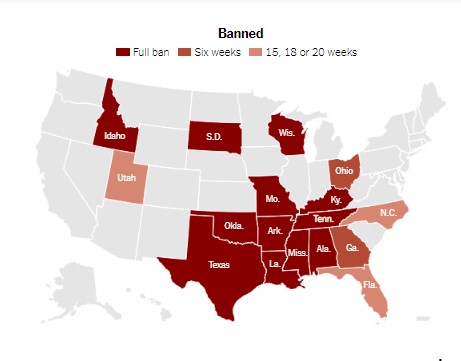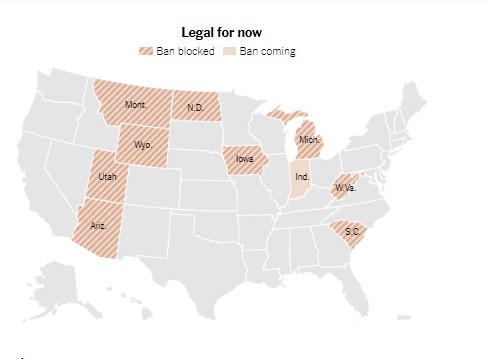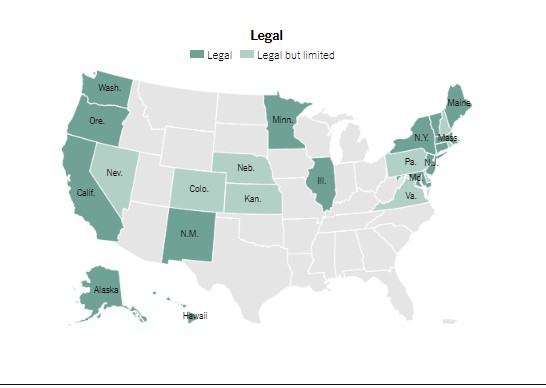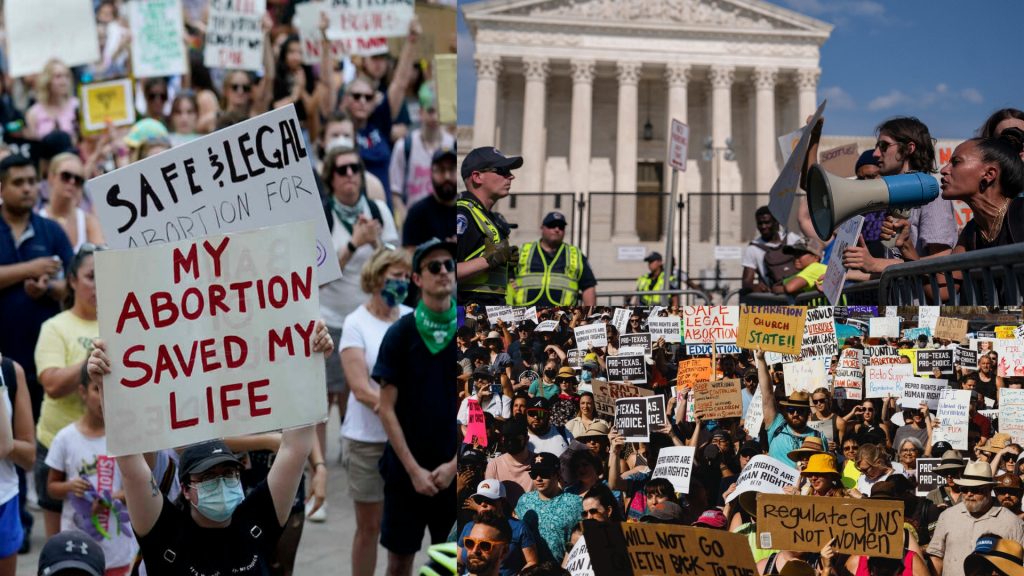Last June of 2022, The Supreme Court overturned its decision in 1973 Roe v. Wade that established the right to an abortion. This ruling marks a shift in abortion law and will make new rules limiting or completely banning access to abortion in almost half of the states.
It has upended 50 years of precedent and given state lawmakers across the country the power to restrict or ban abortion. According to CBS News, Thirteen states have so-called “trigger laws” on the books, in which abortion will swiftly be outlawed in most cases. In the June 24 ruling, the court upheld a Mississippi law banning abortion after 15 weeks of pregnancy.
Why is banning abortion a huge concern?
In a general sense, banning abortion laws would strip away women’s rights to safe abortion. It also takes away women’s rights to choose, whether to bear a child or not. The court’s liberal bloc, Justices Stephen Breyer, Sonia Sotomayor, and Elena Kagan, have expressed their dissent over the ruling. “With sorrow — for this court, but more, for the many millions of American women who have today lost a fundamental constitutional protection — we dissent.”
They have expressed that the Constitution now no longer guarantees that a woman with an unplanned pregnancy can make her own decision about whether to bear a child. Moreover, the Constitution also no longer protect women’s reproductive freedom and their ability to participate equally in economic and social life.
Thousands of citizens, especially women, have also expressed dissent. They protested for days both in the streets and on social media.
This afternoon, doctors, politicians and protesters gathered on the steps of Nashville’s courthouse to speak out against Tennessee's total abortion ban, which went into effect today. WPLN's @PaigePfleger was there. https://t.co/bpQoO9kFHR
— WPLN News – Nashville Public Radio (@WPLN) August 25, 2022
Celebrities protesting against the ban on abortion
- Citizens who opposed this ruling also include celebrities. Amy Schumer, alongside Jennifer Lawrence, was on the Freedom Plaza in Washington, D.C. Schumer posted on Instagram about their protest and said: “I don’t have a uterus and she is pregnant but we out here @womensmarch @plannedparenthood #rallyforabortionjustice 🙌🏼🙌🏼🙌🏼”
- Michelle Obama turned to Twitter to express her disappointment. This tweet was supported by Taylor Swift who said: “I’m absolutely terrified that this is where we are – that after so many decades of people fighting for women’s rights to their own bodies, today’s decision has stripped us of that.”
I’m absolutely terrified that this is where we are – that after so many decades of people fighting for women’s rights to their own bodies, today’s decision has stripped us of that. https://t.co/mwK561oxxl
— Taylor Swift (@taylorswift13) June 24, 2022
- Harry Styles also expressed his thoughts on Twitter: “I’m absolutely devastated for the people of America today. Check on your friends. Look after each other. We’re all in this together, and the fight is just beginning. A truly dark day for America.”
- Even Halsey, and many more celebrities.
I have been advocating for abortion, reproductive rights, and bodily integrity for as long as I’ve had a platform and I’m running out of ways to word and frame the severity of the impact that fundamentalism has on our country. 1/2
— h (@halsey) June 24, 2022
Despite these thousands of protests, the ban has been pushed through. Now we are left with the question: how did every state respond to the ruling?
The status of abortion laws for each state

An article from The New York Times stated that most abortions are now banned in 12 states. In addition, two states now ban abortion at about six weeks of pregnancy, which is before many women would know they are pregnant.
Until now, there are still states that continue to fight over access to abortion in courtrooms. Advocates have sued to block the enforcement of laws that would ban abortion.
The New York Times tracked down the current status of abortion laws in each state. About half of the states are expected to enact bans on abortion or other gestational limits on the procedure. In this table is in-depth information on the abortion laws for every state.
States where abortion is banned

| STATE | STATUS OF ABORTION | MORE DETAILS |
| Alabama | BANNED |
|
| Arkansas | BANNED |
“ |
| Idaho | BANNED |
|
| Kentucky | BANNED |
|
| Louisiana | BANNED | “ |
| Mississippi | BANNED | “ |
| Missouri | BANNED | “ |
| Oklahoma | BANNED | “ |
| South Dakota | BANNED | “ |
| Tennessee | BANNED | “ |
| Texas | BANNED | “ |
| Wisconsin | BANNED |
|
States where abortion has a Gestational limit
| STATE | STATUS OF ABORTION | MORE DETAILS |
| Ohio | Gestational limit
Legal Until: 6 weeks |
|
| Georgia | Gestational limit
Legal Until: 6 weeks |
|
| Florida | Gestational limit
Legal Until: 15 weeks |
|
| Utah | Gestational limit
Legal Until: 18 weeks |
|
| North Carolina | Gestational limit
Legal Until: 20 weeks |
|
State where abortion ban is coming
| STATE | STATUS OF ABORTION | MORE DETAILS |
| Indiana | Ban coming
Legal Until: 22 weeks |
|
States where banning is blocked

| STATE | STATUS OF ABORTION | MORE DETAILS |
| Arizona | Ban blocked
Legal Until: Viability |
|
| Iowa | Ban blocked
Legal Until: 22 weeks |
|
| North Dakota | Ban blocked
Legal Until: 22 weeks |
|
| Michigan | Ban blocked
Legal Until: Viability |
|
| Montana | Ban blocked
Legal Until: Viability |
|
| South Carolina | Ban blocked
Legal Until: 22 weeks |
|
| West Virginia | Ban blocked
Legal Until: 22 weeks |
|
| Wyoming | Ban blocked
Legal Until: Viability |
|
States where abortion is legal but limited

| STATE | STATUS OF ABORTION | MORE DETAILS |
| Colorado | Legal but limited
Legal Until: No gestational limit |
|
| Delaware | Legal but limited
Legal Until: Viability |
|
| Kansas | Legal but limited
Legal Until: 22 weeks |
|
| Nebraska | Legal but limited
Legal Until: 22 weeks |
|
| Nevada | Legal but limited
Legal Until: 24 weeks |
|
| New Hampshire | Legal but limited
Legal Until: 24 weeks |
|
| Rhode Island | Legal but limited
Legal Until: Viability |
|
| Pennsylvania | Legal but limited
Legal Until: 24 weeks |
|
| Virginia | Legal but limited
Legal Until: Viability |
|
| Washington, D.C. | Legal but limited
Legal Until: No gestational limit |
|
States where abortion is legal

| STATE | STATUS OF ABORTION | MORE DETAILS |
| Alaska | LEGAL |
|
| California | LEGAL |
|
| Connecticut | LEGAL |
|
| Hawaii | LEGAL |
|
| Illinois | LEGAL |
|
| Maine | LEGAL |
|
| Maryland | LEGAL |
|
| Massachusetts | LEGAL |
|
| Minnesota | LEGAL |
|
| New Jersey | LEGAL |
|
| New Mexico | LEGAL |
|
| New York | LEGAL |
|
| Oregon | LEGAL |
|
| Vermonth | LEGAL |
|
| Washington | LEGAL |
|
Is there an alternative to abortion?
- Many Women’s rights organizations have provided aid for women for safe abortions and its alternatives. Along those alternatives are pills. According to an article from CNBC, precisely because abortions are banned, women might acquire these pills from abroad.

- The abortion pill, mifepristone, is approved in the U.S. to end pregnancies before the 10th week of pregnancy. The Food and Drug Administration first approved the medication in 2000 but required women to obtain it in person under a program that monitors certain drugs for safety risks.
- However, Abortion rights advocates criticized the FDA for its requirements. They stated that mifepristone has a proven track record as a safe and effective way to end early pregnancies.
- Unfortunately, the agency has permanently ended the in-person requirement, which will allow certified pharmacies in the U.S. to fill and send prescriptions by mail.
A threat to Women’s rights
To conclude, banning abortion is taking away women’s right to choose not only for themselves but also for their future. It rids the woman’s power of having the right to live however she wants. Definitely, the Supreme Court’s ruling has turned backward against a progressive society that enables women to have their own choice and safeguard their health and wellbeing.
Until then, stay with us here at Spiel Times for more content.
